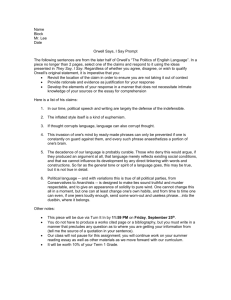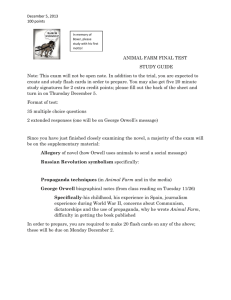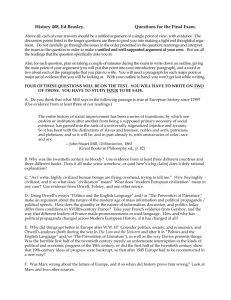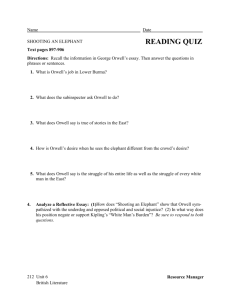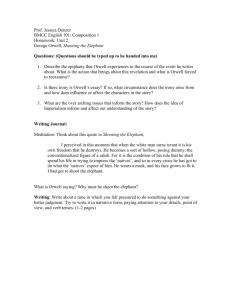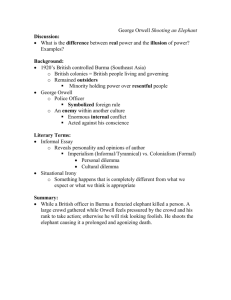AP English Language and Composition: All Politics is Language Ms
advertisement
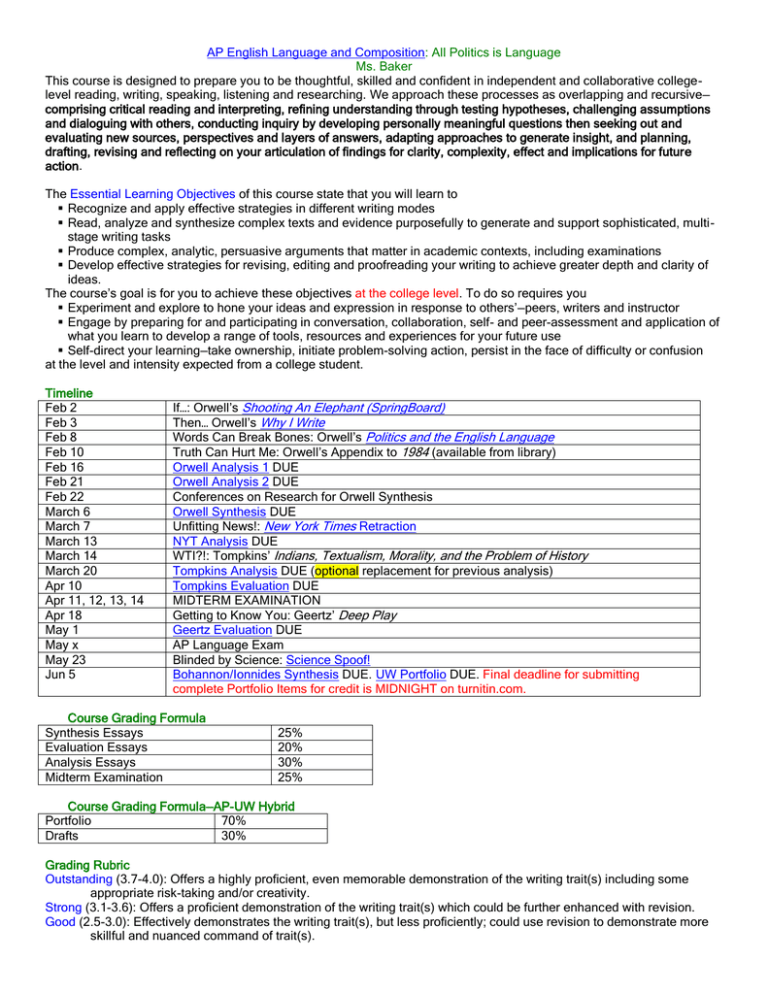
AP English Language and Composition: All Politics is Language Ms. Baker This course is designed to prepare you to be thoughtful, skilled and confident in independent and collaborative collegelevel reading, writing, speaking, listening and researching. We approach these processes as overlapping and recursive— comprising critical reading and interpreting, refining understanding through testing hypotheses, challenging assumptions and dialoguing with others, conducting inquiry by developing personally meaningful questions then seeking out and evaluating new sources, perspectives and layers of answers, adapting approaches to generate insight, and planning, drafting, revising and reflecting on your articulation of findings for clarity, complexity, effect and implications for future action. The Essential Learning Objectives of this course state that you will learn to Recognize and apply effective strategies in different writing modes Read, analyze and synthesize complex texts and evidence purposefully to generate and support sophisticated, multistage writing tasks Produce complex, analytic, persuasive arguments that matter in academic contexts, including examinations Develop effective strategies for revising, editing and proofreading your writing to achieve greater depth and clarity of ideas. The course’s goal is for you to achieve these objectives at the college level. To do so requires you Experiment and explore to hone your ideas and expression in response to others’—peers, writers and instructor Engage by preparing for and participating in conversation, collaboration, self- and peer-assessment and application of what you learn to develop a range of tools, resources and experiences for your future use Self-direct your learning—take ownership, initiate problem-solving action, persist in the face of difficulty or confusion at the level and intensity expected from a college student. Timeline Feb 2 Feb 3 Feb 8 Feb 10 Feb 16 Feb 21 Feb 22 March 6 March 7 March 13 March 14 March 20 Apr 10 Apr 11, 12, 13, 14 Apr 18 May 1 May x May 23 Jun 5 If…: Orwell’s Shooting An Elephant (SpringBoard) Then… Orwell’s Why I Write Words Can Break Bones: Orwell’s Politics and the English Language Truth Can Hurt Me: Orwell’s Appendix to 1984 (available from library) Orwell Analysis 1 DUE Orwell Analysis 2 DUE Conferences on Research for Orwell Synthesis Orwell Synthesis DUE Unfitting News!: New York Times Retraction NYT Analysis DUE WTI?!: Tompkins’ Indians, Textualism, Morality, and the Problem of History Tompkins Analysis DUE (optional replacement for previous analysis) Tompkins Evaluation DUE MIDTERM EXAMINATION Getting to Know You: Geertz’ Deep Play Geertz Evaluation DUE AP Language Exam Blinded by Science: Science Spoof! Bohannon/Ionnides Synthesis DUE. UW Portfolio DUE. Final deadline for submitting complete Portfolio Items for credit is MIDNIGHT on turnitin.com. Course Grading Formula Synthesis Essays Evaluation Essays Analysis Essays Midterm Examination 25% 20% 30% 25% Course Grading Formula—AP-UW Hybrid Portfolio 70% Drafts 30% Grading Rubric Outstanding (3.7-4.0): Offers a highly proficient, even memorable demonstration of the writing trait(s) including some appropriate risk-taking and/or creativity. Strong (3.1-3.6): Offers a proficient demonstration of the writing trait(s) which could be further enhanced with revision. Good (2.5-3.0): Effectively demonstrates the writing trait(s), but less proficiently; could use revision to demonstrate more skillful and nuanced command of trait(s). Acceptable (2.0-2.4): Minimally meets the basic outcome(s) requirement, but the demonstrated writing trait(s) are not fully realized or well-controlled and would benefit from significant revision. Inadequate (0.6-1.9): Does not meet the outcome(s) requirement; the writing trait(s) are not adequately demonstrated and require substantial revision on multiple levels. Incomplete (no grade but equivalent to 0): Does not meet the minimum standards for evaluation. Writing Outcomes and Traits Outcome 1. To demonstrate an awareness of the strategies that writers use in different rhetorical situations: 1.1 Readings recognize and writing employs strategies appropriate to the demands of a particular genre, medium and/or mode. 1.2 Readings recognize and writing shows a clear understanding of its academic audience and various aspects of writing (mode of inquiry, content, structure, appeals, diction and word choice) address and are strategically pitched to that audience. 1.3 Analyses demonstrate the ability to read texts intended for different audiences and contexts. 1.4 The student articulates and assesses the effects of his/her and others’ writing choices. Outcome 2. To read, analyze, and synthesize complex texts purposefully in order to generate and support writing: 2.1 The writing demonstrates an understanding of the readings/evidence as necessary for the purpose at hand. This requires that: a. Readings demonstrate an understanding of a work’s complexity. b. Readings encompass the richness of a work’s meaning. c. Readings analyze how that meaning is embodied in literary form. d. Readings reflect on the social and historical values the work embodies. 2.2 Readings/evidence are used in strategic, focused ways (for example: summarized, cited, applied, challenged, recontextualized) to support the goals of the writing. 2.3 The writing is intertextual, meaning that a "conversation" between texts and ideas is created in support of the writer's goals. (AP refers to this as “synthesis.”) 2.4 The writer utilizes multiple kinds of evidence gathered from various sources (for example: primary, secondary, textual and multimedia) in support of the writer’s goals. Outcome 3. To produce complex, analytic, persuasive arguments that matter in formal academic contexts: 3.1 The argument is appropriately complex, based in a claim that emerges from and explores a line of inquiry. 3.2 The stakes of the argument, why what is being argued matters, are articulated and persuasive. 3.3 The argument involves analysis, which is the close scrutiny and examination of evidence and assumptions in support of a larger set of ideas. 3.4 The argument is persuasive, taking into consideration counterclaims and multiple points of view as it generates its own perspective and position. Outcome 4. To develop effective strategies for planning, drafting, revising, editing, and proofreading writing: 4.1 The writing demonstrates successful revision, resulting in work that meets CCSS standards in language, conventions and style and is characterized by the following (from AP): Wide-ranging vocabulary used with denotative accuracy and connotative resourcefulness. Variety of sentence structures including appropriate use of subordinate and coordinate constructions. Logical organization enhanced by specific techniques of coherence (such as repetition, transitions, emphasis). Balance of generalization with specific, illustrative detail. Effective use of rhetoric including controlled tone and consistent voice. 4.2 The writing demonstrates responsible use of the MLA system of documenting sources. Grading Scale JHS Honors Scale 3.3-4.0 3.0-3.2 2.7-2.9 2.3-2.6 2.0-2.2 1.8-1.9 1.4-1.7 1.1-1.3 0.9-1.0 0.7-0.8 0.0-0.6 Transcript Grade A AB+ B BC+ C CD+ D F Major Assignments Cruelty to Humans (Orwell Analysis 1) Produce an explication of Orwell’s use of elements of narrative structure and style for communicating meaning in Shooting An Elephant using Why I Write as background information for author’s purpose and context. Respond to the prompt: In Why I Write Orwell critiques the relationship between motivations and strategies of authors. Orwell himself made particular choices in composing Shooting An Elephant. Carefully consider each text in relation to the other. Then, argue how an analysis of Shooting An Elephant adds complexity, depth and/or richness to the argument of Why I Write. Avoid mere comparison/contrast. To meet the minimum AP standard you must: meet length requirement of >500 words meet CCSS language, conventions and style standards support a clear, complex, significant and manageable argumentative thesis by integrating arguments and evidence from both texts lay out a rhetorical analysis of Shooting’s structural and stylistic elements/ strategies relevant to your thesis lay out a close reading of passages elucidating Why I Write’s claims/concepts relevant to your thesis accurately apply the class definitions for strategies, elements of literature and devices analyze a variety/range of connections within and between the two readings, including both convergence and divergence cite paraphrases, quotations and/or other material used with applicable MLA in-text format submit to turnitin.com by deadline or lose .2 per calendar day from grade. This Better Be Doubleplusgood! (Orwell Analysis 2) Produce an explication of Orwell’s use of different stylistic techniques to achieve the shared purpose of Politics and the English Language and Appendix of 1984. Respond to the prompt: In Politics Orwell evaluates the real-world effect of language choices by politicians and those with political motives. As part of his dystopic novel 1984, Orwell made the choice to include an appendix (footnoted at the very beginning of the book). Carefully compare the purpose and style (wording, tone, devices) of each text. Then, argue how an analysis of the style of Appendix adds complexity, depth and/or richness to the arguments of Politics. Avoid mere comparison/contrast. To meet the minimum AP standard you must: meet length requirement of >500 words meet CCSS language, conventions and style standards support a clear, complex, significant and manageable argumentative thesis by integrating arguments and evidence from both texts lay out a rhetorical analysis of Appendix’ stylistic elements/strategies relevant to your thesis lay out a close reading of passages elucidating Politics’ claims/concepts relevant to your thesis accurately apply the class definitions for strategies, elements of literature and devices analyze a variety/range of connections within and between the two readings, including both convergence and divergence cite paraphrases, quotations and/or other material used with applicable MLA in-text format submit to turnitin.com by deadline or lose .2 per calendar day from grade. Triplespeak (Orwell Synthesis) Compose an original, formal, research essay developed from re-thinking Orwell and close reading and rhetorical analysis of sources you independently research. Synthesize selected evidence from 3 primary sources related to a political conflict you select with evidence from Orwell to add complexity, depth and/or richness to an academic audience’s existing understanding of that conflict. Respond to the prompt: Orwell’s works argue in varied ways that the use of language often has political motives and political consequences. Consider them carefully, then apply their most significant, relevant arguments to primary sources representative of a recent/current political conflict to articulate your own insight, challenge, exploration or examination of Orwell’s ideas and their applicability to political language today. Avoid mere summary or comparison/ contrast. To meet the minimum AP standard you must: meet length requirement of >1,000 words meet CCSS language, conventions and style standards support a clear, complex, significant and manageable argumentative thesis by integrating evidence from sources and readings rhetorically analyze relevant passages/material from 3 primary sources representing “official” communications of involved parties related to one political conflict—for example, one source could be governmental (such as agency, police chief, etc), one opposition (such as protestor, rebel, etc), and one third party (such as outside organizations— UN, Amnesty International, etc) NO news reporting close read credible secondary source material to corroborate details of conflict (YES news reporting) contextualize the relationship of primary sources to each other and to secondary source material for relevant details in a literature review close read relevant passages encompassing at least one major COMPLEX claim from each of Orwell’s works analyze a variety/range of connections within and between the readings and sources, including both convergences and divergences include support source material and/or tertiary sources for establishing the credibility, authorship and/or context of sources cite paraphrases, quotations and/or other material used with correct MLA in-text and works cited format submit to turnitin.com by deadline or lose .2 per calendar day from grade. Erratum (New York Times Analysis) Produce an explication of the New York Times’ editors’ use of elements of expository structure and style for communicating meaning/purpose in an official retraction by The New York Times using at least 2 professional secondary sources as background information for authors’ purpose and context. Respond to the prompt: In its official retraction of its writer’s journalism, the editors of the New York Times had multiple and even competing purposes and audiences. After informing yourself about the Blair case by reading other sources, argue how an analysis of the strategies the editors use in this text adds complexity, depth and/or richness to the argument being made, including how manipulation by the editors may not succeed with some audiences. Avoid mere summary. To meet the minimum AP standard you must: meet length requirement of >500 words meet CCSS language, conventions and style standards support a clear, complex, significant and manageable argumentative thesis by integrating arguments and evidence from the text and other sources lay out a close reading of passages elucidating the text’s claims/concepts lay out a rhetorical analysis of the text’s structural and stylistic elements/strategies accurately apply the class definitions for strategies, elements of literature and devices include support source material and/or tertiary sources for establishing an understanding of content, audience, purpose and context of the text analyze a variety/range of audiences, effects and strategies, including contradictions or oppositions cite paraphrases, quotations and/or other material used with applicable MLA in-text and works cited format submit to turnitin.com by deadline or lose .2 per calendar day from grade. Believe Half of What You See (Optional Tompkins Analysis) Produce an explication of Tompkins’ use of elements of argumentative structure and style pitched for her specific audience, purpose and context for communicating meaning in Indians. Respond to the prompt: In Indians Tompkins critically reads works from different authors on her subject. Tompkins herself made particular choices in her treatment of the subject. Carefully read both her and her cited works’ treatment of the subject. Then, argue how an analysis of Tompkins’ strategies as a writer adds complexity, depth and/or richness to the argument of Indians. Avoid mere summary or comparison/contrast. To meet the minimum AP standard you must: meet length requirement of >500 words meet CCSS language, conventions and style standards support a clear, complex, significant and manageable argumentative thesis by integrating analysis of the main and cited texts lay out a close reading of passages elucidating Indians’ claims/concepts lay out a rhetorical analysis of Indians’ structural and stylistic strategies accurately apply the class definitions for strategies, elements of literature and devices analyze a variety/range of connections between the main text and cited texts, including both convergence and divergence cite paraphrases, quotations and/or other material used with applicable MLA in-text format submit to turnitin.com by deadline. Believe None of What You Read (Tompkins Evaluation) Produce an evaluation of Tompkins’ essay’s success as a challenge to the “canon” (structuralism) governing the genre, subject and disposition of an academic research essay in the field of history prior to her writing. Respond to the prompt: In Indians Tompkins took up an ideological stance toward data and methods she would use to discuss her subject. After informing yourself about poststructuralism by reading other sources, argue how an analysis of Tompkins’ evidence and approach adds complexity, depth and/or richness to an academic audience’s understanding of poststructuralism as a critical theory. Avoid mere summary or comparison/contrast. To meet the minimum AP standard you must: meet length requirement of >500 words meet CCSS language, conventions and style standards support a clear, complex, significant and manageable argumentative thesis by integrating analysis of the reading with information from sources lay out a close reading of passages discussing Indians’ evidence lay out a rhetorical analysis of Indians’ argumentative strategies analyze a variety/range of connections between the ideology of poststructuralism and the text, including both convergence and divergence include support source material and/or tertiary sources for establishing an understanding of the ideological context of the author and text cite paraphrases, quotations and/or other material used with applicable MLA in-text and works cited format submit to turnitin.com by deadline or lose .2 per calendar day from grade. Chicken! (Geertz Evaluation) Produce an evaluation of Geertz’ Deep Play as a challenge to the “canon” (scientism) governing the genre, subject and disposition of an academic research essay in the field of anthropology prior to his writing. Respond to the prompt: In Deep Play Geertz took up an ideological stance toward data and methods he would use to discuss his subject. After informing yourself about thick description by reading other sources, argue how an analysis of Geertz’ evidence and approach adds complexity, depth and/or richness to an academic audience’s understanding of thick description as a critical theory. Avoid mere summary or comparison/contrast. To meet the minimum AP standard you must: meet length requirement of >500 words meet CCSS language, conventions and style standards support a clear, complex, significant and manageable argumentative thesis by integrating analysis of the reading with information from sources lay out a close reading of passages discussing Deep Play’s evidence lay out a rhetorical analysis of Deep Play’s argumentative strategies analyze a variety/range of connections between the ideology of thick description and the text, including both convergence and divergence include support source material and/or tertiary sources for establishing an understanding of the ideological context of the author and text cite paraphrases, quotations and/or other material used with applicable MLA in-text and works cited format submit to turnitin.com by deadline or lose .2 per calendar day from grade. Plays Well With Others (Bohannon/Ionnides Synthesis) Produce a critical synthesis of the argument promulgated by Bohannon and the methodology/analysis of evidence in contemporary, real-world academic texts. This will require you to develop a complex, original line of inquiry through close reading, rhetorical analysis and intertextual conversation to articulate your own insight, challenge, exploration or examination of Bohannon’s ideas and their applicability to different areas of research. To meet the minimum standards for credit you must: Compose an original, formal, research essay developed from close reading Bohannon and Ionnides and close reading and rhetorical analysis of sources you independently research. Synthesize selected evidence from 3 academic research articles related to one topic you select with evidence from Bohannon and Ionnides to add complexity, depth and/or richness to an academic audience’s understanding of issues of credibility, persuasiveness, value and quality of academic research. Respond to the prompt: Bohannon and Ionnides argue that there are systemic problems with the validity of current academic research methods and application. Consider their reasoning and evidence carefully, then apply their most significant, relevant arguments to sources representative of academic research on a single topic of your choice to articulate your own insight, challenge, exploration or examination of Bohannon’s and Ionnides’ findings and their applicability to research in the future. Avoid mere summary or comparison/contrast. To meet the minimum AP standard you must: meet length requirement of >1,000 words meet CCSS language, conventions and style standards support a clear, complex, significant and manageable argumentative thesis by integrating evidence from sources and readings rhetorically analyze relevant passages/material from 3 sources representing peer-reviewed academic research on a single topic contextualize the relationship of research sources’ data, methods, findings and publication to each other in a literature review close read relevant passages encompassing at least one major COMPLEX claim from Bohannon and from Ionnides analyze a variety/range of connections within and between the readings and sources, including both convergences and divergences include support source material and/or tertiary sources for establishing the production, authorship and/or context of sources cite paraphrases, quotations and/or other material used with correct MLA in-text and works cited format submit to turnitin.com by deadline or lose .2 per calendar day from grade. AP-UW Portfolio Must contain the following items for credit: 1. Selected, final Analysis Essay meeting minimum standards 2. Selected, final Evaluation Essay meeting minimum standards 3. Selected, final Synthesis Essay meeting minimum standards 4. Final Evaluation meeting minimum standards Must be submitted to turnitin.com by final deadline for credit AP-UW Final Evaluation Compose a formal letter addressed to your “13th year” organization/school/program, in which you summarize the process you developed for researching and writing during this course evaluate your Portfolio’s strengths and weaknesses for each course outcome lay out next steps for addressing weaknesses relevant to researching and writing in your chosen discipline. Daily Class Activities and Notes February 2 Ready to s t r e t c h your skills and knowledge from Fall? Matthew Arnold, an eminent literary critic, says in Culture and Anarchy, …culture is "the disinterested and active use of reading, reflection and observation…[true culture] consists in becoming something rather than in having something, an inward condition of the mind and spirit [whose aim is a] perfection in which characters of beauty and intelligence are both present, which unites 'the two noblest things,' sweetness and light." (qtd in Appiah "Racial Identities" 53) We start this semester with a piece of nonfiction that, unlike Rodriguez, Anzaldúa and Baldwin, incorporates all the structural AND stylistic elements of literature you would find for fiction—you know, your favs: Setting Characterization Plot Structure Theme Narration/Point of View Style Tone Literary Devices. Considering the effect on meaning of ALL of these in nonfiction, where they are applicable, adds richness and depth to…wait for it… Close Reading at the College Level This isn’t only reading—it’s writing and thinking, too. To complete a close reading you follow these steps: 1. Decode the text to “get” its meaning (look up interfering “known unknowns”). 2. State a hypothesis: ____ is the significant idea this text argues is true/should be accepted. This should be the overall theme/purpose* 3. Cite the location of necessary data from the text using MLA to clearly, honestly and comprehensively capture where/how this argument shows up in the text—explicitly and implicitly, agreeable to you and not. 4. Justify how the details in your cited data MEAN what you SAY is the argument of the text, by themselves and in context of the whole work (this is taking your interpretation hypothesis…and adding data analysis to back it up)—where elements of literature are used, this is literary analysis of those elements. 5. Draw its implications: __ is how this text’s argument likely relates to argument(s) above and beyond it that I think are worth pursuing. * The operational definition of the term “meaning” for AP is complex. That is, it…ahem…means different things: the connotations and denotations of the words in the text (what it actually says implicitly and explicitly) AND/OR the argument or theme of the work (what if taken together the text proves/tests for the reader) AND/OR the author’s purpose for writing the work (what the work was intended to do/cause/be in the real world of the author)—this is sometimes close to its theme/argument but, logically, always broader. Think: why write this work this way at this time for this audience—instead of other ways/works/times/audiences. Author’s purpose is, by definition, logically related to what you were taught for creative literature as a work’s theme. Many analysts have difficulty differentiating them from each other. Try this to help YOU do it: Theme is the message to the reader the author communicates through his/her story’s argument. Purpose is the MOTIVATION the author has to create THAT story when, where, for whom and how he/she did. Thus, theme is an outcome. The author’s motivation to achieve__( goal)__ CAUSES him/her to create a story that shows _(a specific argument) for his/her intended readers and contemporary context. This CAUSE in the real world leads to the outcome that appears in the form of the story. Today, decode Shooting An Elephant (in the SpringBoard books), gathering data that will make it possible for you to, ultimately, explicate it. Spoiler… What’s an explication? It’s the official name for the formal analysis in any discipline (you can explicate a building design, a grant proposal, a piece of art, a patient’s treatment plan, etc). For literary analysis, it proves you’re right about WHAT the elements of a literary work are [you accurately applied the definition], HOW they work together [you accurately traced shared relationships/ overlapping patterns] and WHY they have an impact on the meaning of the work [you logically laid out the steps of cause to effect] Explication logically proves default claims about a narrative’s structural elements (we’ll be adding stylistic elements later): 1. 2. 3. 4. 5. The use of A, B, C setting(s) accomplishes ___ in the work The use of A, B, C characterization accomplishes ___ in the work The use of A, B, C plot structure accomplishes ___ in the work The use of A, B, C aspects of narration accomplishes ___ in the work. X theme is the best definition of the work’s message to the reader communicated by the use of A, B, C elements in the work February 3 Judith Butler, pioneer gender theorist and literary critic says, We [must] submit ourselves to a process of cultural translation. The point is not to assimilate foreign or unfamiliar notions of humanness into our own as if it is simply a matter of incorporating alienness into an established lexicon. Cultural translation is also a process of yielding our most fundamental categories, that is, seeing how and why they break up, require resignification when they encounter the limits of an available episteme: what is unknown or not yet known. It is crucial to recognize that the notion of the human will only be built over time in and by the process of cultural translation, where it is not a translation between two languages that stay enclosed, distinct, unified. But rather, translation will compel each language to change in order to apprehend the other, and this apprehension, at the limit of what is familiar, parochial, and already known, will be the occasion for both an ethical and social transformation. It will constitute a loss, a disorientation, but one in which the human stands a chance of coming into being anew. ("Beside Oneself" 130-1) Which just might be the best segue ever between Shooting An Elephant and another piece by Orwell, this one less “literary” more “expository” nonfiction: Why I Write. Close read the argument and choices about how to make it in this text (handouts) as if you were answering the default AP exam text prompt*: In a well-supported essay, analyze the techniques the author uses to communicate his/her argument in this text. Avoid mere summary. *This is also explication, just not of literary elements (instead it’s rhetorical and argumentative elements)! Hint: If you’re struggling to see “choices”/ “techniques” of an author—EVEN AFTER REVIEWING my Methods of Argument and Literary Devices glossary online—consider how different the approach to the audience (wording, organization, tone, etc) and “proof” of theme (types of “evidence,” assumptions about the audience’s sympathies/politics, etc) are in this from the narration of Shooting an Elephant. February 5 Review what you are going to USE these readings for: Cruelty to Humans (Orwell Analysis 1) Produce an explication of Orwell’s use of elements of narrative structure and style for communicating meaning in Shooting An Elephant using Why I Write as background information for author’s purpose and context. Respond to the prompt: In Why I Write Orwell critiques the relationship between motivations and strategies of authors. Orwell himself made particular choices in composing Shooting An Elephant. Carefully consider each text in relation to the other. Then, argue how an analysis of Shooting An Elephant adds complexity, depth and/or richness to the argument of Why I Write. Avoid mere comparison/contrast. To meet the minimum AP standard you must: meet length requirement of >500 words meet CCSS language, conventions and style standards support a clear, complex, significant and manageable argumentative thesis by integrating arguments and evidence from both texts lay out a rhetorical analysis of Shooting’s structural and stylistic elements/ strategies relevant to your thesis lay out a close reading of passages elucidating Why I Write’s claims/concepts relevant to your thesis accurately apply the class definitions for strategies, elements of literature and devices analyze a variety/range of connections within and between the two readings, including both convergence and divergence cite paraphrases, quotations and/or other material used with applicable MLA in-text format submit to turnitin.com by deadline or lose .2 per calendar day from grade.
